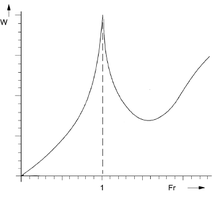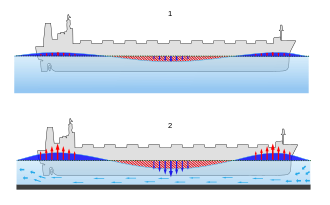Shallow water resistance
The term shallow water resistance describes a resistance- increasing effect on the undercurrent or flow around ships when passing through deep or laterally restricted water, such as when approaching ports on the coast and with many rivers and canals.
definition
The shallow water resistance is basically dependent on the following influencing variables:
- the speed of the ship
- the passing distance
- the ship's dimensions (length, width, draft, submerged main frame cross-section , ship shape),
- the fairway conditions (water level width, bottom width, water depth, cross profile shape and area, bank shape and slope inclination),
- the flow conditions
- the curvature, type of propulsion and density of the water.
If the water is very limited in depth, the flow, i.e. the opening through which the water must flow from the bow to the stern below the ship, is smaller. The smaller the opening between the ship's bottom and the sole , the greater the resistance to be overcome. This effect is also known as the shallow water effect. Additionally or independently of this, a blocking effect can also occur if the fairway is restricted to the side and the lateral flow is restricted.
Shallow water effect
The linear wave theory states that the speed of progress of the wave as well as the wavelength on shallow water decrease as the wave height increases. The waves change their appearance drastically as the water depth decreases.
The speed of progress of the wave is defined as:
With
- = Speed of progress of the wave
- = Wavelength
- = Acceleration due to gravity
Taking into account the water depth, the speed of the wave can also be written as:
With
- = Water depth
- = hyperbolic tangent
If the water depth approaches 0, the limit value of the hyperbolic tangent goes against its function argument . This means that the speed of the wave is independent of its length and only depends on the water depth. The Froude depth number sets this speed of progress of the wave in relation to the speed of progress of the ship.

With
- = Froude depth number
- = Speed of progress of the ship
- = Surge wave velocity
On ships that travel in a flowing state ( ), i.e. at a ship speed lower than the surge wave speed, there is a flowing discharge under the ship's bottom and the journey is referred to as subcritical. The sinking of the ship due to the faster current speed and the simultaneous trimming is called squat . The resistance increases proportionally to the speed of the ship, with a maximum resistance being formed at a critical discharge ( ). In the shooting flow condition ( ), the undercurrent is shooting, the resistance is reduced. Ships that travel faster than the surge speed are called supercritical. Conventional merchant ships usually do not have such a large machine system to overcome the maximum resistance. The effect of the shallow water resistance on the undercurrent under the hull is at the same time the main criterion for the erosion on the river bed.
Blocking effect
The blocking effect, also known as the blocking effect, bank effect or channel effect, can occur in addition to or independently of the shallow water effect when the fairway is laterally restricted , i.e. there is a laterally restricted flow cross-section. In the case of canals and rivers in particular , the flow around the side can be restricted and thus create an additional resistance. With a vertical border between water and mainland, or a vertical slope inclination , as well as when the ship is closer to the shore, the blocking effect increases. This means that the steeper the bank and the narrower the river or canal, the greater the sinking and the resistance to overcome the wave crest at the bow.
See also
Web links
Individual evidence
- ↑ Andreas Matheja, Lutz Schweter: Nature measurements to determine ship-induced loads in the port of a tidal river , communications from the Franzius Institute for Hydraulic Engineering and Coastal Engineering, University of Hanover. Issue 95, Article 2
- ↑ Lecture materials Stefan Krueger (TUHH): Additional resistances , August 17, 2006 (PDF; 983 kB)
- ↑ Illies, Kurt: Schiffs-Antriebsmaschinen , in 75 Jahre Schiffbautechnische Gesellschaft 1899–1974. Hamburg 1974, p. 152
- ↑ W. Führer; K. Römisch: Effects of modern ship traffic on inland and ocean waterways and their structures , 24th International Maritime Congress, Leningrad, pp. 1–3
- ↑ Horst Oebius: Characterization of the influencing variables of the flow around the ship and the propeller jet on the waterways. (pdf; 3.1 MB) In: BAW bulletin no.82 Federal Institute for Hydraulic Engineering , 2000, accessed on July 12, 2016 .
literature
- S. Schuster: Investigation of flow and resistance conditions when ships travel on restricted water , Yearbook of the Shipbuilding Society, 46th vol., 1952
- K. Römisch: Achievable speed and diving of a ship on flat water - a contribution to the optimal dimensioning of inland and sea waterways , Mitteilungen der FAS, H. 24, 1969
- J. Kreitner: About the ship resistance on restricted water , shipyard, shipping company and port, 15, 7, 1934
- HD Krey: Model tests on shipping operations on canals , VDI-Mitt. on research, issue 107, 1911
- H. Lackenby: The effect of Shallow Water on Ship Speed , The Shipbuilder and Marine-Engine Builder, 1963















